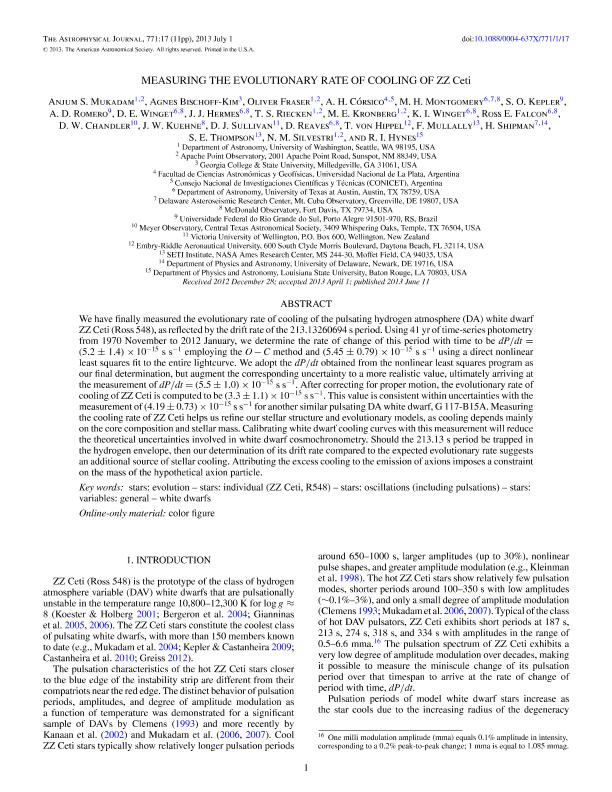Artículo
Measuring the evolutionary rate of cooling of ZZ Ceti
Mukadam, Anjum S. ; Bischoff Kim, Agnes ; Fraser, Oliver; Corsico, Alejandro Hugo ; Montgomery, M. H. ; Kepler, S. O. ; Romero, A. D. ; Winget, D. E. ; Hermes, J. J. ; Riecken, T. S. ; Kronberg, M. E. ; Winget, K. I. ; Falcon, Ross E. ; Chandler, D. W. ; Kuehne, J. W. ; Sullivan, D. J. ; Reaves, D. ; von Hippel, T. ; Mullally, F. ; Shipman,H. ; Thompson, S. E. ; Silvestri, N. M. ; Hynes, R. I.
; Montgomery, M. H. ; Kepler, S. O. ; Romero, A. D. ; Winget, D. E. ; Hermes, J. J. ; Riecken, T. S. ; Kronberg, M. E. ; Winget, K. I. ; Falcon, Ross E. ; Chandler, D. W. ; Kuehne, J. W. ; Sullivan, D. J. ; Reaves, D. ; von Hippel, T. ; Mullally, F. ; Shipman,H. ; Thompson, S. E. ; Silvestri, N. M. ; Hynes, R. I.
 ; Montgomery, M. H. ; Kepler, S. O. ; Romero, A. D. ; Winget, D. E. ; Hermes, J. J. ; Riecken, T. S. ; Kronberg, M. E. ; Winget, K. I. ; Falcon, Ross E. ; Chandler, D. W. ; Kuehne, J. W. ; Sullivan, D. J. ; Reaves, D. ; von Hippel, T. ; Mullally, F. ; Shipman,H. ; Thompson, S. E. ; Silvestri, N. M. ; Hynes, R. I.
; Montgomery, M. H. ; Kepler, S. O. ; Romero, A. D. ; Winget, D. E. ; Hermes, J. J. ; Riecken, T. S. ; Kronberg, M. E. ; Winget, K. I. ; Falcon, Ross E. ; Chandler, D. W. ; Kuehne, J. W. ; Sullivan, D. J. ; Reaves, D. ; von Hippel, T. ; Mullally, F. ; Shipman,H. ; Thompson, S. E. ; Silvestri, N. M. ; Hynes, R. I.
Fecha de publicación:
07/2013
Editorial:
Iop Publishing
Revista:
Astrophysical Journal
ISSN:
0004-637X
Idioma:
Inglés
Tipo de recurso:
Artículo publicado
Clasificación temática:
Resumen
We have finally measured the evolutionary rate of cooling of the pulsating hydrogen atmosphere (DA) white dwarf ZZ Ceti (Ross 548), as reflected by the drift rate of the 213.13260694 s period. Using 41 yr of time-series photometry from 1970 November to 2012 January, we determine the rate of change of this period with time to be dP/dt = (5.2 ± 1.4) × 10–15 s s–1 employing the O – C method and (5.45 ± 0.79) × 10–15 s s–1 using a direct nonlinear least squares fit to the entire lightcurve. We adopt the dP/dt obtained from the nonlinear least squares program as our final determination, but augment the corresponding uncertainty to a more realistic value, ultimately arriving at the measurement of dP/dt = (5.5 ± 1.0) × 10–15 s s–1. After correcting for proper motion, the evolutionary rate of cooling of ZZ Ceti is computed to be (3.3 ± 1.1) × 10–15 s s–1. This value is consistent within uncertainties with the measurement of (4.19 ± 0.73) × 10–15 s s–1 for another similar pulsating DA white dwarf, G 117-B15A. Measuring the cooling rate of ZZ Ceti helps us refine our stellar structure and evolutionary models, as cooling depends mainly on the core composition and stellar mass. Calibrating white dwarf cooling curves with this measurement will reduce the theoretical uncertainties involved in white dwarf cosmochronometry. Should the 213.13 s period be trapped in the hydrogen envelope, then our determination of its drift rate compared to the expected evolutionary rate suggests an additional source of stellar cooling. Attributing the excess cooling to the emission of axions imposes a constraint on the mass of the hypothetical axion particle.
Archivos asociados
Licencia
Identificadores
Colecciones
Articulos(IALP)
Articulos de INST.DE ASTROFISICA LA PLATA
Articulos de INST.DE ASTROFISICA LA PLATA
Citación
Mukadam, Anjum S. ; Bischoff Kim, Agnes ; Fraser, Oliver; Corsico, Alejandro Hugo; Montgomery, M. H. ; et al.; Measuring the evolutionary rate of cooling of ZZ Ceti; Iop Publishing; Astrophysical Journal; 771; 7-2013; 17-28
Compartir
Altmétricas



